So... I have studied Mars in great detail this summer in what is deemed to be its closest approach to Earth in over 50,000 years. And here are images of the planet as I saw it through my Tal-1 Russian reflector. The first 2 photographs are from the early 'approach phase' when Mars was still at distances of 79 million miles (20 May 2003) and 49 million miles (8 July 2003):-
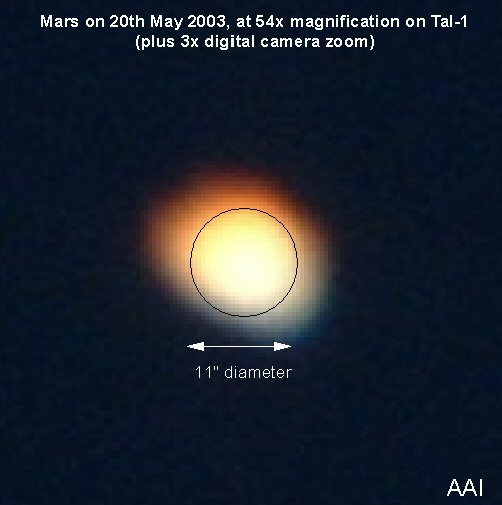
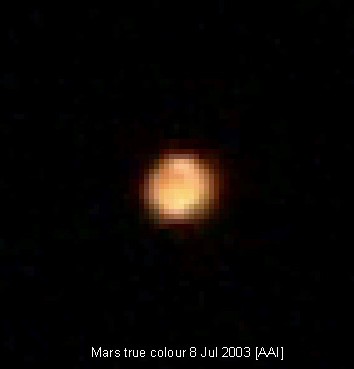
The next set of images is at 10 days before closest approach and opposition, taken on 16 August 2003 when the planet was at a range of just 35 million miles from Earth, shining brilliantly in our skies at -2.7 magnitude with a fiery yellow/orange glow. My pictures are 100% true colour with no graphic enhancements of any kind and they show the very prominent, snowy white Martian south polar ice cap in unmistakeable form:-
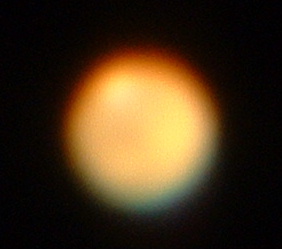
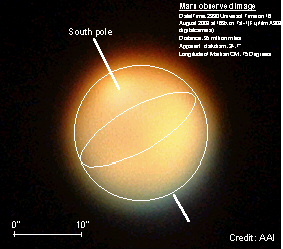
Looking at these images in detail, I have to emphasize here, I do not see any canals or little green men... but if you make out any of these features in my pictures, you should let me know!
To see how Mars would have looked from a space based telescope at the same instant when I took my latest photos above, with crisp resolution and no atmospheric blur, here is a real time simulated view of Mars to match with my latest images above:
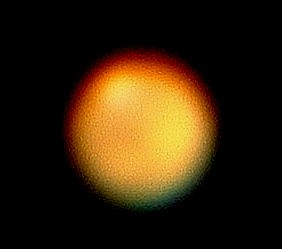
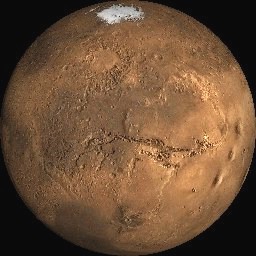
Above left: My actual observed image
Above right: Simulated real time view at the same instant
Mars' surface coordinates of the centre of the apparent disk at this instant was 59 degrees west longitude and -19 degrees south latitude - just south of the central region of the Valles Marineris canyon system. If you look at my slightly contrast-enhanced image above, you will note the light/dark shadings on the apparent disk broadly correspond with the physical surface markings! Is that EPIC or WHAT?
In particular, the lighter 'yellow' region in the right half of the disk in my photo is the famous volcanic Tharsis Montes region, as more clearly shown on the surface simulated view. This region looks clearly brighter having a higher relative albedo (ratio of incident sunlight to reflected sunlight) compared to the darker regions east of the Valles Marineris canyon (left half of the disk on my image). Olympus Mons plus the line of three shield volcanoes (Arsia Mons, Ascraeus Mons & Pavonis Mons) shown on the simulated view, were NOT SEEN in my telescopic view... but could of course be imagined in the mind's eye! Come to think of it, no Earth surface-based telescope has ever photographed these volcanoes to my knowledge.
The season in Mars' southern hemisphere is now late spring/early summer meaning that the south polar ice cap should be shrinking, but it is still looking significantly more extended in my photos than that depicted in the 'simulated' picture shown above. The Martian south pole is currently tilted roughly 20 degrees towards both the Earth and the Sun.
At the centre point of the apparent disk in my above image (59 deg. W, -19 deg. S), down on the surface of Mars it is currently midday with the Sun passing very close to overhead in the local sky, and the current surface temperature at this point in the Martian tropics, based on data from the thermal emission spectrometer (TES) on the Mars Global Surveyor spacecraft, reads a comfortable +15 to +20 degrees celsius! This is above average, since Mars is now close to perihelion (closest to the Sun) in its 687-day orbit.
![This plot shows the Martian surface temperature vs. latitude for MGS Orbit 19798 data received and processed on 4 September 2003 [Credit: Arizona state university]](marstemp.gif)
(Click image for larger view)
Southern hemisphere summers on Mars are expected to be significantly warmer than those in the northern hemisphere, since Mars is much closer to the Sun in its highly eccentric orbit when they occur - see Martian seasons.
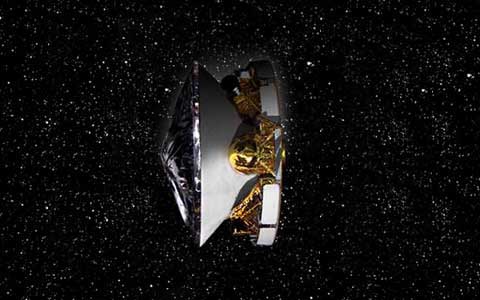
Above: An artist's concept of one of the twin-Mars Exploration Rover spacecraft carrying the names of 3.5 million people en-route to Mars right at this instant!
![An artist's impression of the 2001 Mars Polar Lander spacecraft which may be resting on the Martian surface... somewhere! [Credit: www.solarviews.com]](http://www.solarviews.com/browse/craft/mpl3.jpg)
Above: An artist's impression of the 2001 Mars Polar Lander spacecraft which may be resting on the Martian surface... somewhere! [Credit: www.solarviews.com]


Copyright © 2003 Abdul Ahad. All rights reserved.